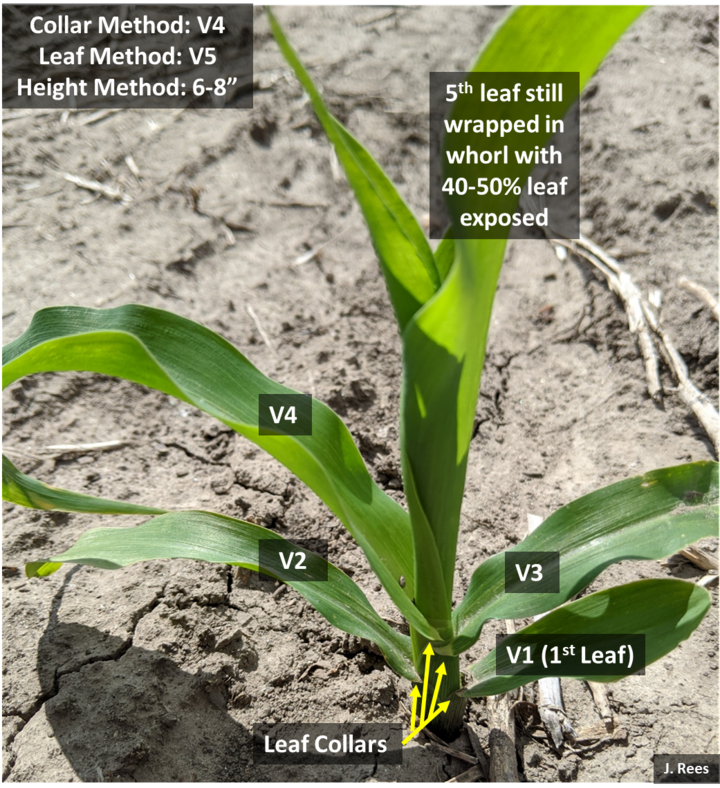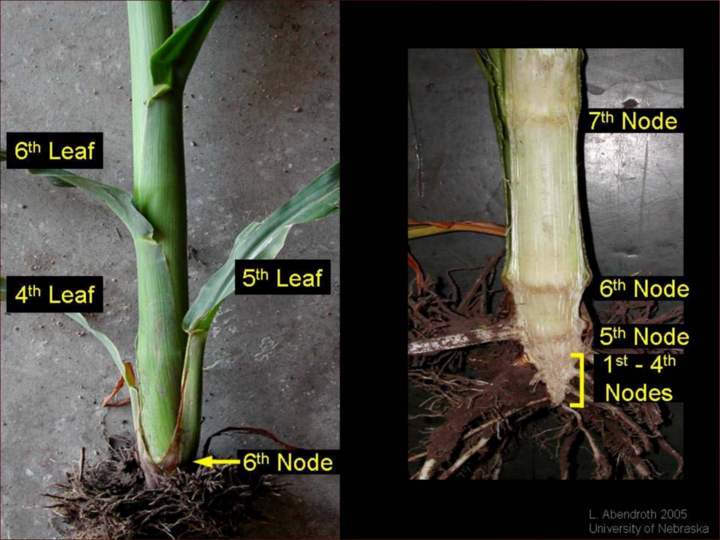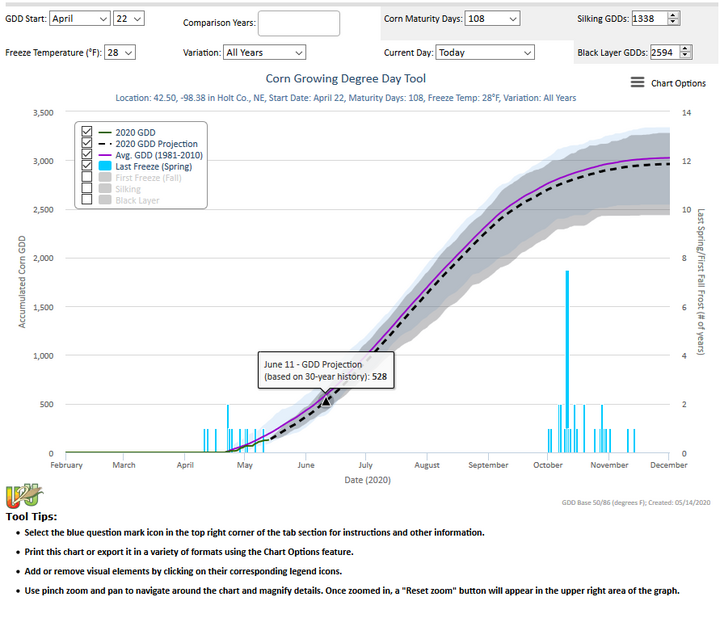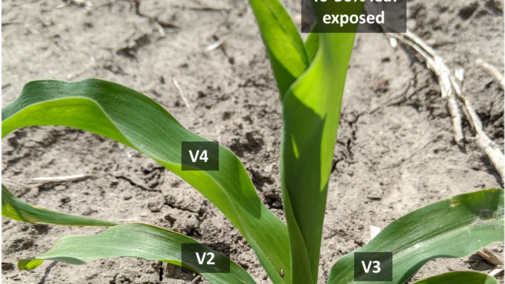The freeze we experienced the first weekend in May caused several corn plants to suffer severe leaf damage. Whether it is this event or an early season hail event, being able to accurately growth stage the growing corn can be challenging for producers and crop consultants. After a frost, or hail event, the dead tissue is not able to resurrect itself and is eventually sloughed off as the plant continues to grow. Thus a common question is how do I determine corn growth stage when I can no longer count leaves? To answer this question, it is critical to understand leaf staging corn by the leaf collar method, leaf method, and plant height method.
It is important to accurately growth stage corn particularly if you are planning to apply a post-emergence herbicide because each herbicide has restriction based on corn growth stage or plant height (Table 1). Herbicide applications made past the recommended application stages can result in significant crop injury. Some herbicides can be applied later according to the label using drop nozzles which prevent the herbicide being sprayed into the whorl.
Leaf Collar Method
This is the most accurate and commonly used method by agricultural professionals. A collar develops at the leaf base near the stalk after each leaf fully expands. Think about collars like the collar on a button-down shirt. The collar flares slightly at one’s neck, just as a true exposed leaf collar flares at the base of the leaf at the stem. Start counting leaves at the base of the plant with the smallest rounded-tip leaf with a collar as #1. From there count every leaf with a true collar. Leaves that are still wrapped in the whorl around the main stem without exposed leaf collars are not counted. Each leaf with a collar is assigned a number and these numbers are described as vegetative stages (Abendroth et al., 2011). For example, Figure 1 shows a plant with 4 leaf collars, thus it is considered to be at the V4 growth stage.

Leaf Method (also referred to as “Droopy” Leaf Method by Nielsen)
Crop insurance adjusters primarily use this method. While it begins with the first small rounded leaf like the leaf collar method, it also counts leaves within the whorl with 40-50% of the leaf exposed. Nielsen (2019) calls it “droopy” leaf because you count the last leaf that tips “droops” or hangs down which typically occurs once corn reaches knee-high. Thus, the growth stage is often 1-2 leaves more than the leaf collar method. For example, in Figure 1, the same plant that is considered V4 using the leaf collar method is considered V5 in this case using the leaf method.
Plant Height Method
In this method, a plant height is used to determine the restriction on when plants can no longer be sprayed with pesticide applications. This is perhaps the most problematic and dangerous method to use in growth staging plants. The reason is that plants can differ in height every year due to environmental factors. Warm conditions can lead to rapid plant growth, longer internodes, and taller plants while cooler conditions lead to shorter plants and can have shortened internode lengths. What may look like a V8 plant one year or in one field may be a V10 plant another based on height alone.
Help for Staging with Lower Leaf Loss Prior to V5-V6
Walk damaged and recovering fields while damaged leaves are still attached to the plant. Mark 10 consecutive plants with plot flags or garden stakes. Identify and record the leaf number of the lowermost healthy leaf (one that will remain attached for some time). Mark the leaf that will remain by ripping the leaf, using a pen or sharpie, painting the leaf or tying a small zip tie/string to the base of the leaf and use the same method for the remaining nine plants. Scout the field in one week or later to stage the plants again. Find the marked leaf on each plant and continue counting the number of leaves with visible collars. Note: marking a known plant leaf and watching that same plant throughout the growing season is a helpful trick to use for growth staging in any field situation.
In situations where there is no leaf to be able to mark, record the number of leaves that were present in a notebook or mobile device that can be referenced as the plants continue to grow.
Help for Staging with Lower Leaf Loss After V5-V6
The growing point emerges above ground between V5-V6. After that point, splitting the stalk becomes the most accurate way to determine plant growth stage when lower leaves are absent. To stage using this technique, dig a plant without breaking the stalk. Carefully split the stalk down the middle through the root ball. At the base of the stalk is an inverted triangle that contains Nodes 1-4 (but they can’t be differentiated). Next look for the white area above that (about ½-3/4”) followed by the next visible band. The white area is the internode with the band being the 5th node (V5). There’s about an inch of internode between V5 and V6. After that, internode length is more dependent upon air temperature instead of soil temperature. Every leaf is attached to a node. Pull off the fully collared leaves and follow them back to where they break off at a specific node. Count the nodes on the stalk to the highest collared leaf that breaks off at a node to determine the growth stage. (Figure 2).

Alternative Staging Method for Any Growth Stage
The U2U Corn GDD tool can also be of help. At the site, you can select your location and then have it generate a graph for you. You input the date you want to start GDD accumulation (either from planting or emergence), input the GDD to silking and maturity from your seed company for the particular hybrid. There is a strong correlation between corn development and temperature. Abendroth et al. at Iowa State showed it takes from 90-120 GDD from planting to emergence while Nielsen at Purdue found 115-120 GDD. Additional factors such as planting depth and residue cover may impact GDDs and a table in this article shows those adjustments. If you know the emergence date and input it, the graph will be more accurate in the U2U tool. From growth stage V1-V10, it requires about 82 GDDs per leaf while it requires around 50 GDDs per leaf from V11 to the last leaf.
Figure 3 shows an example of how to calculate estimated V5 growth stage for corn planted in Holt County on April 22nd. On May 9th, corn was varying in growth stage of emergence to V1e with 113 GDDs accumulation. A frost occurred on the night of May 9th, so we want to make a prediction of when the corn will be a V5-V6 for post-application herbicide to be applied. It takes 82 GDD per leaf (82 x 5 leaf stages = 410 GDD), 410 GDD + 113 = 523. Based on where 523 GDD occur with the U2U model for this hybrid at this location in 2020, V5 would be approximately June 11th (Figure 4). This is an estimate of what the GDD will be on that particular day. This method is a way to help predict or estimate the possible last day to apply post-emergence corn herbicides. Thorough scouting and examination of plants around this date and accurately growth stage is highly encouraged to avoid potential herbicide damage.


Important Things to Remember before Applying a Post-emergence Corn Herbicide
The use of post-emergence herbicides are an important tool in the overall weed management plan. Here are some points to consider to assure a successful weed management plan using a post-emergence herbicides:
- Always pay attention to the growth stage or height noted on the label prior to application. Application beyond that point may result in crop injury.
- Absorption of post-emergence herbicide and potential crop injury are influenced by environmental conditions. Avoid herbicide applications when the crop and weeds are under stress.
- Always follow herbicide product labels regarding spray additives that can be used or recommended to improve herbicide efficacy.
- Do NOT apply post-emergence herbicides with foliar fungicides or nitrogen fertilizer.
- Take appropriate steps to properly clean sprayer tanks to avoid potential tank contamination and crop injury.
- The use of drop nozzles can be used for taller corn for better weed management but following label instructions if this is allowed.
- If post-emergence herbicides are applied later than mentioned on the product label, corn ear development can be affected.
Summary
The leaf collar and split stalk methods are the most accurate in using the plant to properly growth staging corn. The U2U GDD tool can aid in predicting when a specific growth stage will occur. Using proper growth staging methods are especially important to avoid crop damage as one makes post-herbicide and other post-pesticide applications.
| Post-emergence Corn Herbicide | Corn Growth Stage or Plant Height |
|---|---|
| 2,4-D | Spike to 36” |
| Accent Q | Up to V5 with drops up to V9 Popcorn, sweetcorn & seedcorn up to V5 |
| Accent Q + Atrazine DF | Less than 12” |
| Acuron | 12” |
| Aim EC | V8-V14 |
| Armezon | V8 |
| Armezon + Atrazine DF | 12” |
| Armezon Pro + Glyphosate | V8 to 30” |
| Atrazine DF | 12” |
| Basis Blend | V2 |
| Beacon | 20” |
| Buctril + Atrazine | 12” |
| Cadet | 48” |
| Callisto | 30” or V8 |
| Capreno | V1-V6 or 20” |
| Curtail | V4 |
| DiFlexx | V6 or 36” |
| DiFlexx DUO | V6 or 36” |
| Enlist ONEa | V8 or 30” |
| Enlist DUOa | V8 |
| Expert | 12” |
| Glyphosate | V12 or 48” |
| Halex GT | V8 or 30” |
| Harness Max | V3 |
| Hornet WDG | 20” |
| Impact | 45 days pre-harvest |
| Laudis | V9 |
| Liberty/Interline/Cheetahb | V6 or 24” |
| Permit | 20” |
| Realm Q | V6 |
| Resicore | 12” |
| Resolve Q | V6 |
| Resource | V10 |
| Revulin-Q | V6 |
| Shieldex | V6 or 20” |
| Solstice | V8 or 30” |
| Spirit | 24” |
| Starane Ultra | V5 Sweetcorn V4 |
| Status | V8 or 36” |
| Steadfast Q | V6 or 20” |
| Stout | V5 or 16” |
| Vida | V4 or 12” |
| Yukon | 36” |
a Enlist ONE and Enlist DUO can be applied only in Enlist corn.
b Liberty/Interline/Cheetah can be applied only in LibertyLink corn
For more information on efficacy of the herbicides in Table 1, refer to the 2020 Guide for Weed, Disease, and Insect Management in Nebraska.
References
Abendroth, L.J., R.W Elmore, M.J. Boyer, and S.K. Marlay. 2011. Corn Growth and Development. Iowa State Univ. Extension Publication #PMR-1009. https://store.extension.iastate.edu/Product/Corn-Growth-and-Development [URL accessed May 2020].
Nielson, R.L. (Bob). 2019. Determine Corn Leaf Stages. Corny News Network, Purdue Univ. [On-line]. Available at https://www.agry.purdue.edu/ext/corn/news/timeless/VStageMethods.html. [URL accessed May 2020].
Nielsen, R.L. (Bob). 2019. Use Thermal Time to Predict Leaf Stage Development in Corn. Corny News Network, Purdue Univ. [On-Line]. Available at http://www.kingcorn.org/news/timeless/VStagePrediction.html. [URL accessed May 2020].

